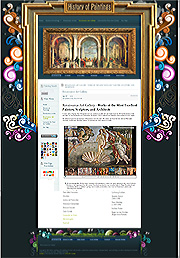Early Works of Leonardo da Vinci
HIS EARLY WORKS
To about the year 1472 belongs the small picture of the “Annunciation,” now in the Louvre, which after being the subject of much contention among European critics has gradually won its way to general recognition as an early work by Leonardo himself. That it was painted in the studio of Verrocchio was always admitted, but it was long catalogued by the Louvre authorities under the name of Lorenzo di Credi. It is now, however, attributed to Leonardo (No. 1602 A). Such uncertainties as to attribution were common half a century ago when scientific art criticism was in its infancy.
Here You Can Find Rare Antique and Collectibles
Another painting of the “Annunciation,” which is now in the Uffizi Gallery (No. 1288) is still officially attributed to Leonardo. This small picture, which has been considerably repainted, and is perhaps by Andrea del Verrocchio, Leonardo’s master.

Generally thought to be the earliest extant work entirely by Leonardo. The work was traditionally attributed to Verrocchio until 1869. It is now almost universally attributed to Leonardo. Attribution proposed by Liphhart, accepted by Bode, Lubke, Muller-Walde, Berenson, Clark, Goldscheider and others.
To January 1473 belongs Leonardo’s earliest dated work, a pen-and-ink drawing—”A Wide View over a Plain,” now in the Uffizi. The inscription together with the date in the top left-hand corner is reversed, and proves a remarkable characteristic of Leonardo’s handwriting—viz., that he wrote from right to left; indeed, it has been suggested that he did this in order to make it difficult for any one else to read the words, which were frequently committed to paper by the aid of peculiar abbreviations.
Here You Can Find Rare Antique and Collectibles
Leonardo continued to work in his master’s studio till about 1477. On January 1st of the following year, 1478, he was commissioned to paint an altar-piece for the Chapel of St. Bernardo in the Palazzo Vecchio, and he was paid twenty-five florins on account. He, however, never carried out the work, and after waiting five years the Signoria transferred the commission to Domenico Ghirlandajo, who also failed to accomplish the task, which was ultimately, some seven years later, completed by Filippino Lippi. This panel of the “Madonna Enthroned, St. Victor, St. John Baptist, St. Bernard, and St. Zenobius,” which is dated February 20, 1485, is now in the Uffizi.
That Leonardo was by this time a facile draughtsman is evidenced by his vigorous pen-and-ink sketch—now in a private collection in Paris—of Bernardo Bandini, who in the Pazzi Conspiracy of April 1478 stabbed Giuliano de’ Medici to death in the Cathedral at Florence during High Mass. The drawing is dated December 29, 1479, the date of Bandini’s public execution in Florence.
In that year also, no doubt, was painted the early and, as might be expected, unfinished “St. Jerome in the Desert,” now in the Vatican, the under-painting being in umber and terraverte. Its authenticity is vouched for not only by the internal evidence of the picture itself, but also by the similarity of treatment seen in a drawing in the Royal Library at Windsor. Cardinal Fesch, a princely collector in Rome in the early part of the nineteenth century, found part of the picture—the torso—being used as a box-cover in a shop in Rome. He long afterwards discovered in a shoemaker’s shop a panel of the head which belonged to the torso. The jointed panel was eventually purchased by Pope Pius IX., and added to the Vatican Collection.
In March 1480 Leonardo was commissioned to paint an altar-piece for the monks of St. Donato at Scopeto, for which payment in advance was made to him. That he intended to carry out this contract seems most probable. He, however, never completed the picture, although it gave rise to the supremely beautiful cartoon of the “Adoration of the Magi,” now in the Uffizi (No. 1252). As a matter of course it is unfinished, only the under-painting and the colouring of the figures in green on a brown ground having been executed. The rhythm of line, the variety of attitude, the profound feeling for landscape and an early application of chiaroscuro effect combine to render this one of his most characteristic productions.
Here You Can Find Rare Antique and Collectibles
Vasari tells us that while Verrocchio was painting the “Baptism of Christ” he allowed Leonardo to paint in one of the attendant angels holding some vestments. This the pupil did so admirably that his remarkable genius clearly revealed itself, the angel which Leonardo painted being much better than the portion executed by his master. This “Baptism of Christ,” which is now in the Accademia in Florence and is in a bad state of preservation, appears to have been a comparatively early work by Verrocchio, and to have been painted in 1480-1482, when Leonardo would be about thirty years of age.
To about this period belongs the superb drawing of the “Warrior,” now in the Malcolm Collection in the British Museum. This drawing may have been made while Leonardo still frequented the studio of Andrea del Verrocchio, who in 1479 was commissioned to execute the equestrian statue of Bartolommeo Colleoni, which was completed twenty years later and still adorns the Campo di San Giovanni e Paolo in Venice.
Source:The Project Gutenberg: Leonardo da Vinci, by Maurice W. Brockwell



You must be logged in to post a comment.